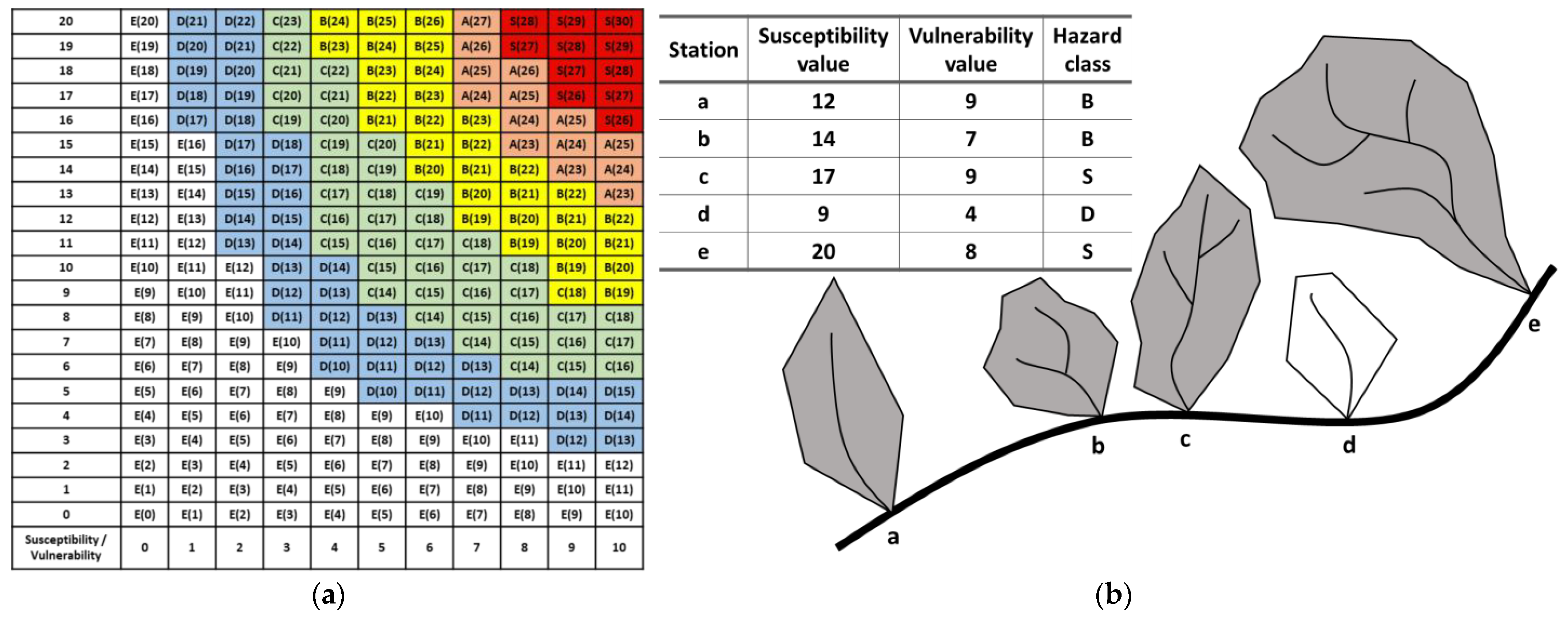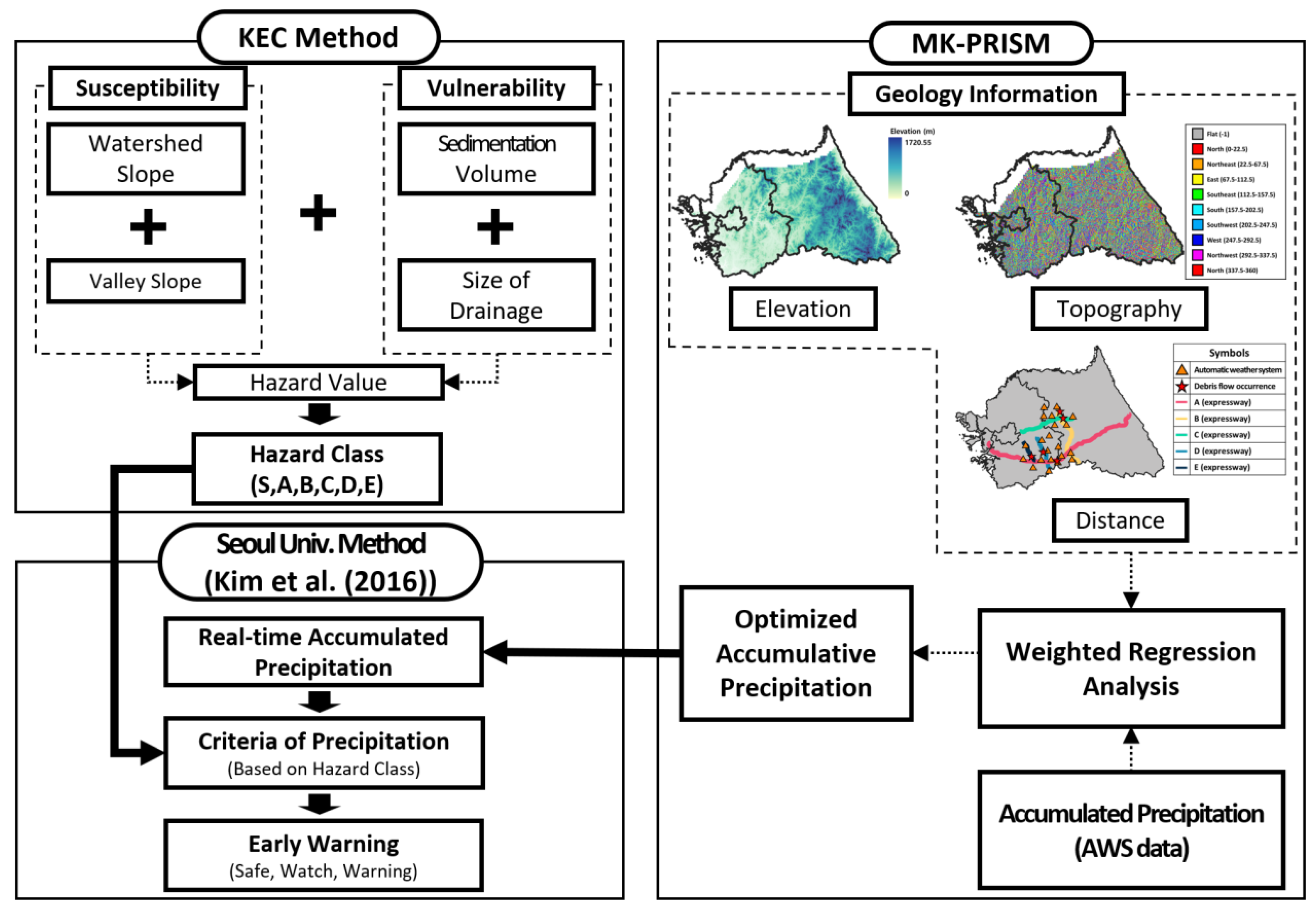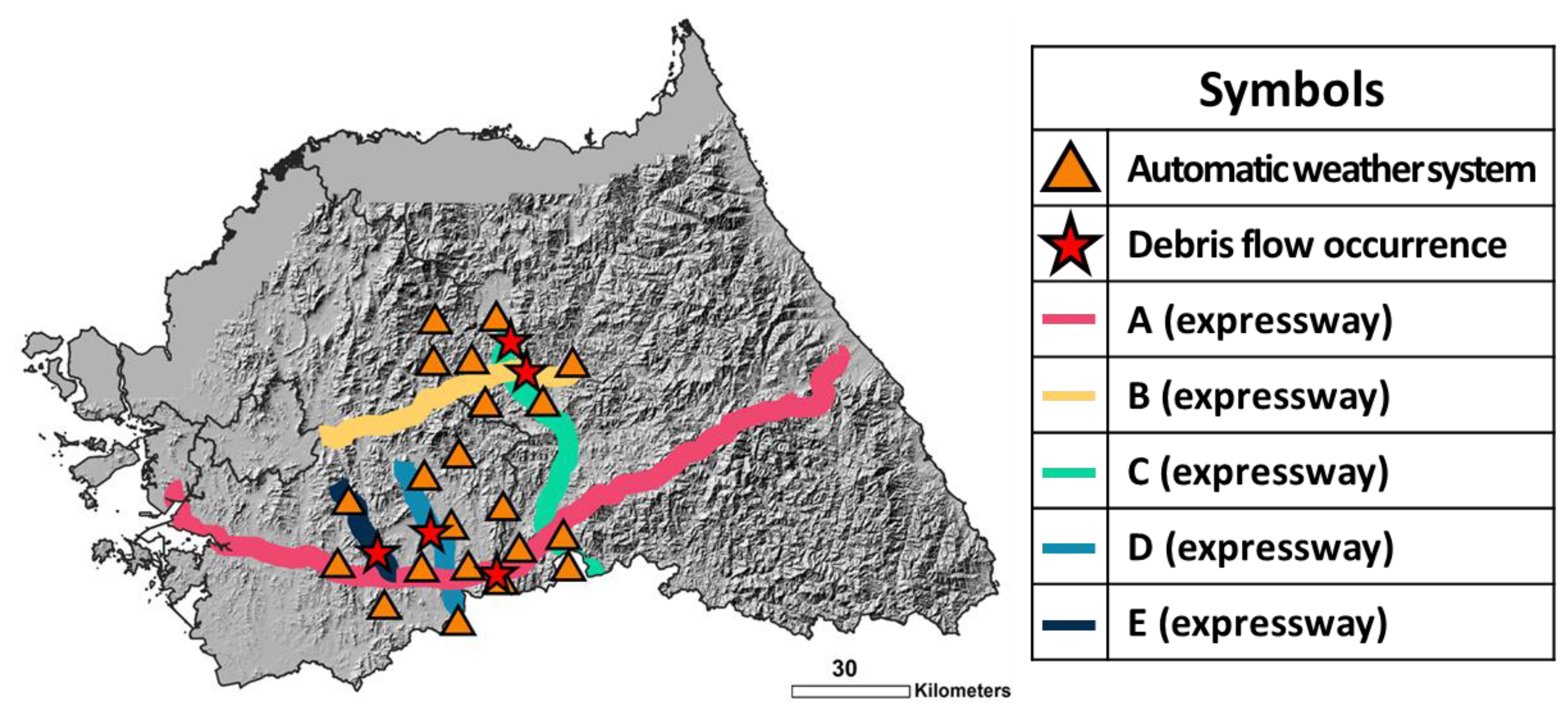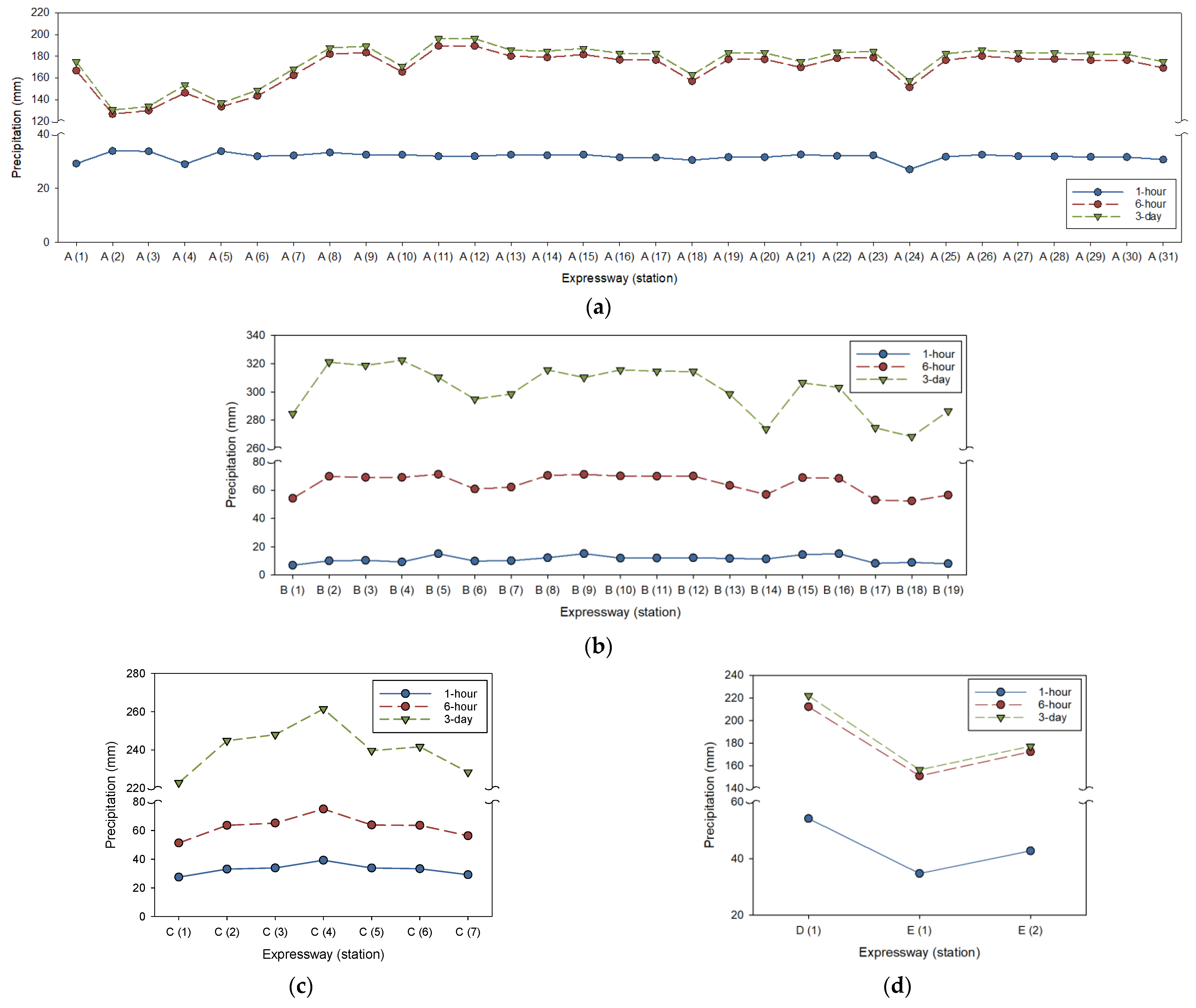Assessment of Debris Flow Triggering Rainfall Using Parameter-Elevation Relationships on an Independent Slope Model
Abstract
1. Introduction
2. Materials and Methods
2.1. Debris Flow Hazard Assessment Methods in South Korea
2.2. Real-Time Debris Flow Prediction System Utilizing Parameter-Elevation Relationsips on Independent Slope Model
3. Results
3.1. Analysis of a Debris Flow Occurrence Site
3.2. Performance of Real-Time Debris Flow Prediction Systems
- -
- Case A: Predicted debris flow occurrence with Watch or Warning at actual occurrence sites
- -
- Case B: Predicted safety at non-occurrence sites
- -
- Case C: Predicted Watch or Warning at non-occurrence sites
- -
- Case D: Predicted safety at occurrence sites
4. Discussion
4.1. Real-Time Debris Flow Prediction System
4.2. Limitations and Future Works
- -
- Data limitations: This study was conducted using data from only five expressway segments and a limited number of AWS stations, which may not fully capture the variability of debris flow-triggering rainfall conditions in different regions. Terrain, geology, and climate conditions vary significantly and the results may not be directly generalizable to areas with different mountain ranges, soil types, or vegetation coverage. Future studies should incorporate a more diverse set of monitoring sites and compare results with similar studies to improve the generalizability of conclusions.
- -
- Size of the validation dataset: The PRISM-based system was validated using a relatively small dataset of observed debris flow events. The limited sample size may introduce biases and restrict the comprehensive evaluation of model performance across various complex scenarios. Expanding the validation dataset with cases covering different spatial and temporal conditions, as well as diverse triggering factor combinations, is necessary for a more robust assessment.
- -
- Temporal granularity of rainfall: While this study considered cumulative rainfall over various time scales, it did not address potential delays between rainfall events and debris flow occurrence. Incorporating such temporal dynamics through time series analysis could further improve prediction accuracy.
- -
- Expansion of datasets: Future research should include a more extensive dataset that includes debris flow events from a diverse set of climatic, geologic, and topographic conditions to improve model robustness and generalizability. The integration of data from multiple sources, such as satellite precipitation estimates and high-resolution weather radar data, could also enhance the accuracy of rainfall-triggered debris flow predictions.
- -
- Development of dynamic rainfall threshold models: Existing threshold-based methods often assume static triggering conditions. Future research should focus on developing adaptive models that account for antecedent rainfall conditions, soil moisture variability, and evolving thresholds over time to improve the temporal prediction accuracy of early warning systems.
- -
- Advancements in predictive methods: The use of machine learning techniques to analyze complex interactions among topographic, meteorological, and geological variables, as well as time-series analysis (e.g., using long short-term memory or gated recurrent unit models), can identify new patterns and improve predictive performance.
- -
- Real-time system optimization: The implementation of the PRISM-based system in real-time operational environments and its continuous improvement through feedback and performance monitoring will ensure practical applicability and scalability.
- -
- Wireless sensor network (WSN) for deformation monitoring: Advanced sensor-based monitoring technologies, such as WSNs and GNSS, are being used for real-time detection of ground deformations and early warning systems [44,45]. Fiber-optic sensor technology has also proven effective for infrastructure monitoring, including tunnels and bridges [46]. Future research will explore WSN applications for more accurate assessments of debris flow impacts.
5. Conclusions
Author Contributions
Funding
Institutional Review Board Statement
Informed Consent Statement
Data Availability Statement
Acknowledgments
Conflicts of Interest
References
- Varnes, D.J. Slope movement types and processes. In Landslides: Analysis and Control; Schuster, R.L., Krizek, R.J., Eds.; National Academy of Sciences: Washington, DC, USA, 1978; pp. 11–33. [Google Scholar]
- Iverson, R.M.; Reid, M.E.; LaHusen, R.G. Debris-flow mobilization from landslides. Annu. Rev. Earth Planet. Sci. 1997, 25, 85–138. [Google Scholar] [CrossRef]
- Wang, Z.Y.; Lee, J.H.; Melching, C.S. Debris flows and landslides. In River Dynamics and Integrated River Management; Springer: Berlin/Heidelberg, Germany, 2015; pp. 193–264. [Google Scholar] [CrossRef]
- Tang, C.; van Asch, T.W.; Chang, M.; Chen, G.Q.; Zhao, X.H.; Huang, X.C. Catastrophic debris flows on 13 August 2010 in the Qingping area, southwestern China: The combined effects of a strong earthquake and subsequent rainstorms. Geomorphology 2012, 139, 559–576. [Google Scholar] [CrossRef]
- Jakob, M.; Hungr, O. Debris-Flow Hazards and Related Phenomena, 2nd ed.; Springer: Berlin/Heidelberg, Germany, 2005; Volume 739. [Google Scholar] [CrossRef]
- Cui, P.; Zhou, G.G.; Zhu, X.H.; Zhang, J.Q. Scale amplification of natural debris flows caused by cascading landslide dam failures. Geomorphology 2013, 182, 173–189. [Google Scholar] [CrossRef]
- Kean, J.W.; Staley, D.M.; Lancaster, J.T.; Rengers, F.K.; Swanson, B.J.; Coe, J.A.; Lindsay, D.N. Inundation, flow dynamics, and damage in the 9 January 2018 Montecito debris-flow event, California, USA: Opportunities and challenges for post-wildfire risk assessment. Geosphere 2019, 15, 1140–1163. [Google Scholar] [CrossRef]
- Lee, I.J.; Lee, D.H.; Suh, Y.C. GIS-based analysis of the debris flow occurrence possibility using an airborne LiDAR DEM around Pyeongchang-gun, Kangwon-do. J. Korean Assoc. Geogr. Inf. Stud. 2010, 13, 50–66. [Google Scholar] [CrossRef]
- Nam, D.H.; Kim, M.I.; Kang, D.H.; Kim, B.S. Debris flow damage assessment by considering debris flow direction and direction angle of structure in South Korea. Water 2019, 11, 328. [Google Scholar] [CrossRef]
- Dowling, C.A.; Santi, P.M. Debris flows and their toll on human life: A global analysis of debris-flow fatalities from 1950 to 2011. Nat. Hazards 2014, 71, 203–227. [Google Scholar] [CrossRef]
- Chen, J.G.; Chen, X.Q.; Wang, T.; Zou, Y.H.; Zhong, W. Types and causes of debris flow damage to drainage channels in the Wenchuan earthquake area. J. Mt. Sci. 2014, 11, 1406–1419. [Google Scholar] [CrossRef]
- Huang, Y.; Zhang, B. Challenges and perspectives in designing engineering structures against debris-flow disaster. Eur. J. Environ. Civ. Eng. 2022, 26, 4476–4497. [Google Scholar] [CrossRef]
- Santi, P.M.; Hewitt, K.; VanDine, D.F.; Barillas Cruz, E. Debris-flow impact, vulnerability, and response. Nat. Hazards 2011, 56, 371–402. [Google Scholar] [CrossRef]
- Woo, C.; Kwon, H.; Lee, C.; Kim, K. Landslide hazard prediction map based on logistic regression model for applying in the whole country of South Korea. J. Korean Soc. Hazard Mitig. 2014, 14, 117–123. [Google Scholar] [CrossRef]
- Yeon, Y.K. Evaluation and analysis of Gwangwon-do landslide susceptibility using logistic regression. J. Korean Assoc. Geogr. Inf. Stud. 2011, 14, 116–127. [Google Scholar] [CrossRef]
- Lee, S.; Choi, U. Development of GIS-based geological hazard information system and its application for landslide analysis in Korea. Geosci. J. 2003, 7, 243–252. [Google Scholar] [CrossRef]
- Dai, F.C.; Lee, C.F. Landslide characteristics and slope instability modeling using GIS, Lantau Island, Hong Kong. Geomorphology 2002, 42, 213–228. [Google Scholar] [CrossRef]
- Lv, W.; Hu, X.; Li, X.; Zhao, J.; Liu, C.; Li, S.; Zhu, H. Multi-model comprehensive inversion of surface soil moisture from Landsat images based on machine learning algorithms. Sustainability 2024, 16, 3509. [Google Scholar] [CrossRef]
- Bostan, T. Generating a landslide susceptibility map using integrated meta-heuristic optimization and machine learning models. Sustainability 2024, 16, 9396. [Google Scholar] [CrossRef]
- Nieto, N.; Chamorro, A.; Echaveguren, T.; Escauriaza, C. Fragility curves for road embankments exposed to adjacent debris flow. Prog. Phys. Geogr. Earth Environ. 2022, 47, 105–122. [Google Scholar] [CrossRef]
- Nieto, N.; Chamorro, A.; Echaveguren, T.; Sáez, E.; González, A. Development of fragility curves for road embankments exposed to perpendicular debris flows. Geomat. Nat. Hazards Risk 2021, 12, 1560–1583. [Google Scholar] [CrossRef]
- Wu, J.; Chen, G.Q.; Zheng, L.; Zhang, Y.B. GIS-based numerical modelling of debris flow motion across three-dimensional terrain. J. Mt. Sci. 2013, 10, 522–531. [Google Scholar] [CrossRef]
- Chen, C.Y.; Yu, F.C. Morphometric analysis of debris flows and their source areas using GIS. Geomorphology 2011, 129, 387–397. [Google Scholar] [CrossRef]
- Kim, H.S.; Chung, C.K.; Kim, S.R.; Kim, K.S. A GIS-based framework for real-time debris-flow hazard assessment for expressways in Korea. Int. J. Disaster Risk Sci. 2016, 7, 293–311. [Google Scholar] [CrossRef]
- Gu, F.; Chen, J.; Sun, X.; Li, Y.; Zhang, Y.; Wang, Q. Comparison of machine learning and traditional statistical methods in debris flow susceptibility assessment: A case study of Changping district, Beijing. Water 2023, 15, 705. [Google Scholar] [CrossRef]
- Lang, Q.; Liu, P.; Zhang, Y.; Zhang, J.; Huang, J. Risk assessment of debris flow disasters triggered by an outburst of Huokou Lake in Antu County based on an information quantity and random forest approach. Sustainability 2024, 16, 9545. [Google Scholar] [CrossRef]
- Korea Expressway Corporation (KEC)—Research Institute. Debris Flow Countermeasures Along the Expressway Through Risk Assessment; Korea Expressway Corporation Research Report; Korea Expressway Corporation (KEC)—Research Institute: Gimcheon-si, Republic of Korea, 2013. [Google Scholar]
- Korea Forest Service. Guidelines for the Survey of Landslide-Prone Areas and the Identification and Management of Vulnerable Areas; Korea Forest Service: Daejeon, Republic of Korea, 2020.
- Lee, S.U.; Sin, J.H. Development of disaster prevention design technology for mountain roads. Korean Soc. Road Eng. 2013, 15, 49–60. [Google Scholar] [CrossRef]
- Kim, K.S. Characteristics of basin topography and rainfall triggering debris flow. KSCE J. Civ. Environ. Eng. Res. 2008, 28, 263–271. [Google Scholar] [CrossRef]
- Jo, B.H. Optimal Assessment of Rainfall Triggering Debris Flow Using Parameter-Elevation Relationships on Independent Slopes Model. Master’s Thesis, Seoul National University, Seoul, Republic of Korea, February 2017. [Google Scholar] [CrossRef]
- Crosta, G.B.; Frattini, P. Rainfall thresholds for triggering soil slips and debris flow. In Proceedings of the 2nd EGS Plinius Conference on Mediterranean Storms, Siena, Italy, 14–16 October 2000; Volume 1, pp. 463–487. [Google Scholar]
- Wilson, R.C.; Wieczorek, G.F. Rainfall thresholds for the initiation of debris flows at La Honda, California. Environ. Eng. Geosci. 1995, 1, 11–27. [Google Scholar] [CrossRef]
- Ham, D.H.; Hwang, S.H.; Kim, H.J. Review of domestic landslide and debris flow forecast standard using hydrologic data. In Proceedings of the Korean Society of Civil Engineers Conference, Gangwon, Republic of Korea, 23 October 2013. [Google Scholar]
- Daly, C.; Gibson, W.P.; Taylor, G.H.; Johnson, G.L.; Pasteris, P. A knowledge-based approach to the statistical mapping of climate. Clim. Res. 2002, 22, 99–113. [Google Scholar] [CrossRef]
- Hong, K.O.; Suh, M.S.; Rha, D.K.; Chang, D.H.; Kim, C.; Kim, M.K. Estimation of high-resolution gridded temperature using GIS and PRISM. Atmosphere 2007, 17, 255–268. [Google Scholar]
- Shin, S.C.; Kim, M.K.; Suh, M.S.; Rha, D.K.; Jang, D.H.; Kim, C.S.; Lee, W.S.; Kim, Y.H. Estimation of high-resolution gridded precipitation using GIS and PRISM. Atmosphere 2008, 18, 71–81. [Google Scholar]
- Daly, C.; Neilson, R.P.; Phillips, D.L. A statistical-topographic model for mapping climatological precipitation over mountainous terrain. J. Appl. Meteorol. Climatol. 1994, 33, 140–158. [Google Scholar] [CrossRef]
- Daly, C.; Halbleib, M.; Smith, J.I.; Gibson, W.P.; Doggett, M.K.; Taylor, G.H.; Pasteris, P.P. Physiographically sensitive mapping of climatological temperature and precipitation across the conterminous United States. Int. J. Climatol. 2008, 28, 2031–2064. [Google Scholar] [CrossRef]
- Choi, E.B.; Park, J.H.; Sano, M.; Nakatsuka, T.; Seo, J.W. Summer climate information recorded in tree-ring oxygen isotope chronologies from seven locations in the Republic of Korea. Front. For. Glob. Change 2024, 7, 1269346. [Google Scholar] [CrossRef]
- Bae, T.S.; Lee, J.; Kwon, J.H.; Hong, C.K. Update of the precision geoid determination in Korea. Geophys. Prospect. 2012, 60, 555–571. [Google Scholar] [CrossRef]
- Kil, Y.; Ahn, K.S.; Woo, K.S.; Lee, K.C.; Jwa, Y.J.; Jung, W.; Sohn, Y.K. Geoheritage values of the Quaternary Hantangang river volcanic field in the central Korean Peninsula. Geoheritage 2019, 11, 765–782. [Google Scholar] [CrossRef]
- Lee, S.; Kim, K.S.; Lee, K.H.; Jang, H.I.; You, B.O. Public expressway debris flow characteristics. In Proceedings of the 9th Korea-Japan Joint Symposium on Slope Stability, Seoul, Republic of Korea, 16–17 October 2016; pp. 95–102. [Google Scholar]
- Jeong, S.; Ko, J.; Kim, J. The effectiveness of a wireless sensor network system for landslide monitoring. IEEE Access 2019, 8, 8073–8086. [Google Scholar] [CrossRef]
- Hamza, V.; Stopar, B.; Sterle, O.; Pavlovčič-Prešeren, P. A cost-effective GNSS solution for continuous monitoring of landslides. Remote Sens. 2023, 15, 2287. [Google Scholar] [CrossRef]
- Velha, P.; Nannipieri, T.; Signorini, A.; Morosi, M.; Solazzi, M.; Barone, F.; Frisoli, A.; Ricciardi, L.; Eusepi, R.; Icardi, M.; et al. Monitoring large railways infrastructures using hybrid optical fibers sensor systems. IEEE Trans. Intell. Transp. Syst. 2019, 21, 5177–5188. [Google Scholar] [CrossRef]




| Hazard Class | Hazard Level | Recurrence Interval | Countermeasure |
|---|---|---|---|
| S | Very high probability of debris flow and road damage | Approximately 2–5 years | Needs to be established |
| A | High probability of debris flow and road damage | Approximately 5–20 years | |
| B | Likely occurrence of debris flow and road damage | Approximately 20–50 years | |
| C | Possible occurrence of debris flow and road damage | Exceeding 50 years | Observation required |
| D | Low probability of debris flow occurrence and road damage | Approximately 1000 years | Does not need to be established |
| E | Very low probability of debris flow occurrence or road damage | - |
| Hazard Class | Accumulative Precipitation (mm) | ||
|---|---|---|---|
| 1 Hour | 6 Hours | 3 Days | |
| S | 35 | 90 | 220 |
| A | 45 | 125 | 320 |
| B | 60 | 160 | 420 |
| C | 75 | 195 | 520 |
| D | 95 | 270 | 720 |
| Expressway | Number of the Station | Susceptibility Value | Vulnerability Value | Hazard Class | ||||
|---|---|---|---|---|---|---|---|---|
| Mean Watershed Slope (°) | Rate of Area in Watershed with Slopes over 35° (%) | Mean Valley Slope (°) | Ratio of Length of Valley with Slopes over 15° (%) | Deposit Volume (m3) | Drainage Facility | |||
| A | (11) | 31.0 | 23.1 | 48.0 | 92.8 | 980.0 | Waterway box below B4.0 × 4.0 | B |
| B | (14) | 39.4 | 66.6 | 30.3 | 100.0 | 0.0 | Waterway | S |
| (18) | 21.3 | 8.7 | 12.5 | 73.2 | 0.0 | Waterway | B | |
| C | (5) | 35.8 | 44.5 | 58.1 | 69.2 | 49.0 | Lateral drains | S |
| D | (1) | 32.1 | 39.1 | 26.4 | 91.7 | 28.4 | Lateral drains | A |
| E | (1) | 20.5 | 2.4 | 13.0 | 35.9 | 0.0 | Waterway | C |
| Expressway | Evaluated Period | Accumulative Precipitation (mm) | Early Warning Result | ||||||
|---|---|---|---|---|---|---|---|---|---|
| 1 Hour | 6 Hours | 3 Days | S | A | B | C | D | ||
| A | July 2013 | 34.5 | 222 | 229 | Warning | Caution | Caution | Caution | Safe |
| B | July 2013 | 4.5 | 44.5 | 249 | Caution | Safe | Safe | Safe | Safe |
| C | June–July 2013 | 0.5 | 5 | 164 | Caution | Caution | Safe | Safe | Safe |
| D | July 2013 | 74.5 | 284.5 | 287 | Warning | Warning | Warning | Caution | Caution |
| E | July 2013 | 16 | 166.5 | 182.5 | Caution | Caution | Caution | Safe | Safe |
| Expressway | Number of Stations | Accumulative Precipitation (mm) | |||||
|---|---|---|---|---|---|---|---|
| 1 Hour | 6 Hours | 3 Days | |||||
| Max. | Mean | Max. | Mean | Max. | Mean | ||
| A | 31 | 33.86 | 31.78 | 189.60 | 169.00 | 196.31 | 174.69 |
| B | 19 | 15.19 | 11.26 | 71.27 | 64.60 | 322.53 | 301.75 |
| C | 7 | 39.30 | 32.89 | 75.03 | 62.73 | 261.48 | 240.97 |
| D | 1 | 54.14 | 212.13 | 221.92 | |||
| E | 2 | 42.73 | 38.73 | 172.38 | 161.73 | 177.25 | 166.86 |
| Expressway | Number of the Station | Early Warning Result | |
|---|---|---|---|
| Seoul Nat’l Univ. Method [24,31] | Real-Time Debris Flow Prediction System Utilizing PRISM | ||
| A | (1), (2), (5), (9) | Safe | Safe |
| B | (1), (2), (3), (5), (6), (7), (8), (9), (10), (11), (12), (13), (15), (16), (17), (19) | ||
| C | (1), (2), (3), (5), (6), (7) | ||
| E | (2) | ||
| B | (4) | Safe | Watch |
| A | (3), (4), (6), (7), (12), (13), (24), (25), (31) | Watch | Safe |
| C | (4) | ||
| A | (8), (10), (11), (14), (15), (16), (17), (18), (19), (20), (21), (22), (23), (26), (27), (28), (29), (30) | Watch | Watch |
| B | (14), (18) | ||
| D | (1) | ||
| E | (1) | ||
Disclaimer/Publisher’s Note: The statements, opinions and data contained in all publications are solely those of the individual author(s) and contributor(s) and not of MDPI and/or the editor(s). MDPI and/or the editor(s) disclaim responsibility for any injury to people or property resulting from any ideas, methods, instructions or products referred to in the content. |
© 2025 by the authors. Licensee MDPI, Basel, Switzerland. This article is an open access article distributed under the terms and conditions of the Creative Commons Attribution (CC BY) license (https://creativecommons.org/licenses/by/4.0/).
Share and Cite
Jo, B.-H.; Chung, T.-K.; Kim, I. Assessment of Debris Flow Triggering Rainfall Using Parameter-Elevation Relationships on an Independent Slope Model. Sustainability 2025, 17, 1499. https://doi.org/10.3390/su17041499
Jo B-H, Chung T-K, Kim I. Assessment of Debris Flow Triggering Rainfall Using Parameter-Elevation Relationships on an Independent Slope Model. Sustainability. 2025; 17(4):1499. https://doi.org/10.3390/su17041499
Chicago/Turabian StyleJo, Bum-Hee, Taek-Kyu Chung, and Inhyun Kim. 2025. "Assessment of Debris Flow Triggering Rainfall Using Parameter-Elevation Relationships on an Independent Slope Model" Sustainability 17, no. 4: 1499. https://doi.org/10.3390/su17041499
APA StyleJo, B.-H., Chung, T.-K., & Kim, I. (2025). Assessment of Debris Flow Triggering Rainfall Using Parameter-Elevation Relationships on an Independent Slope Model. Sustainability, 17(4), 1499. https://doi.org/10.3390/su17041499







